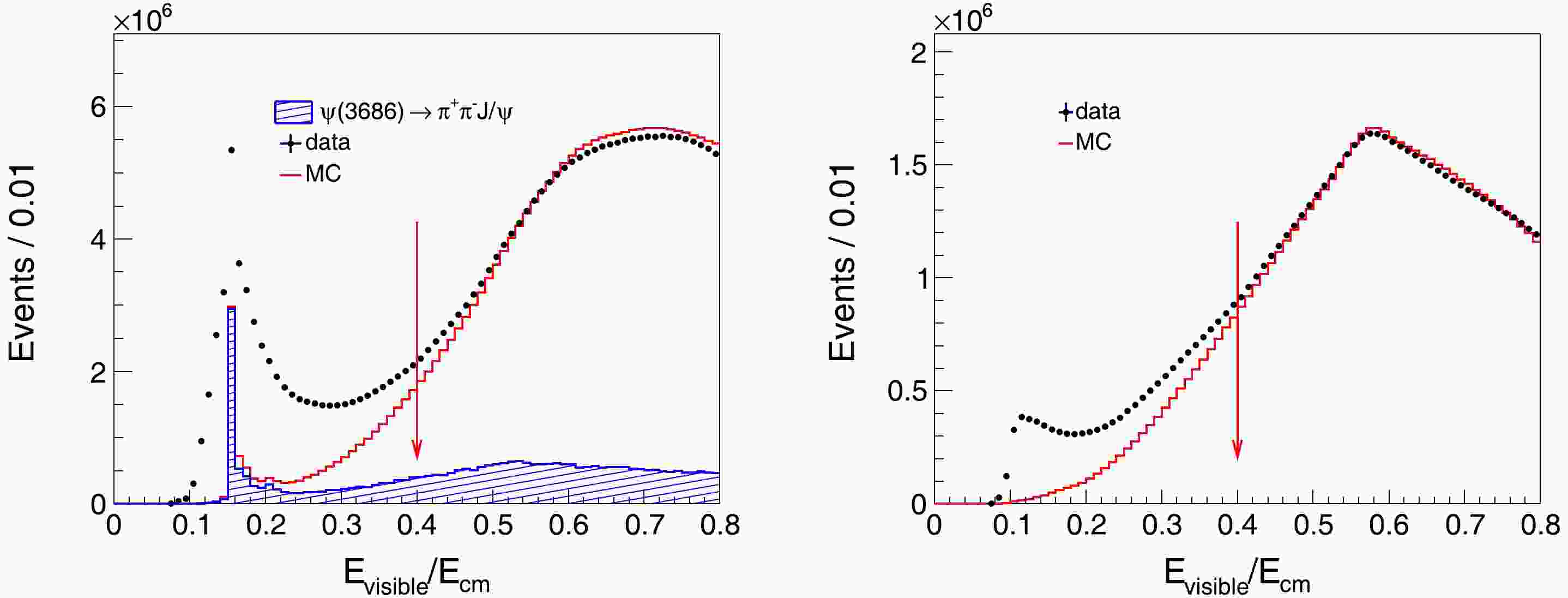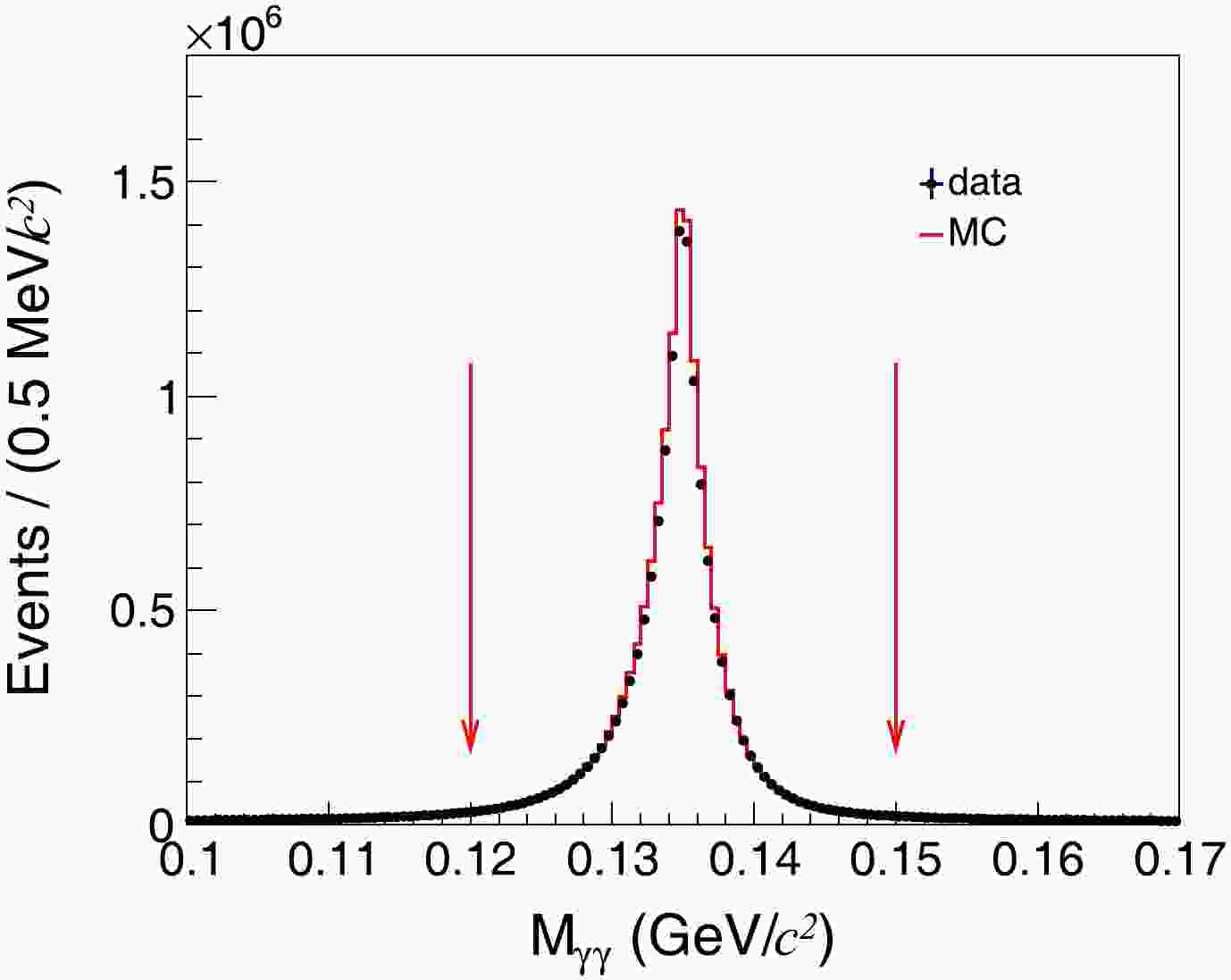-
In 2009, 2012, and 2021, the BESIII experiment accumulated the world's largest ψ(3686) data sample produced in electron-positron collisions, thereby providing an excellent platform to precisely study the transitions and decays of the ψ(3686) and its daughter charmonium states, including the
$ \chi_{cJ} $ ,$ h_c $ , and$ \eta_c $ , and to search for rare decays with physics beyond the Standard Model. The number of ψ(3686) events,$ N_{\psi(3686)} $ , is a basic input parameter, and its precision has a direct impact on the accuracy of these measurements.In this paper, we determine the number of ψ(3686) events by using inclusive ψ(3686) hadronic decays, where the branching fraction of
$ \psi(3686)\to hadrons $ is known to be (97.85±0.13)% [1−3]. The nonresonant background yield under the ψ(3686) peak is evaluated by analyzing the two off-resonance data samples taken in 2009 and 2021 at a center-of-mass (c.m.) energy$ E_{\rm cm} = 3.65 $ GeV. The same method of background estimation was successfully used in our previous measurement of the numbers of ψ(3686) events in the data samples collected in 2009 and 2012 [4]. -
BEPCII [5] is a double-ring
$ e^+e^- $ collider in the center-of-mass energy range from 2.0 to 4.95 GeV which has reached a peak luminosity of 1×1033 cm-2s-1 at$ \sqrt{s} $ = 3.773 GeV. The cylindrical core of the BESIII detector [5] consists of a helium-based multilayer drift chamber (MDC), a plastic scintillator time-of-flight (TOF) system, and a CsI(Tl) electromagnetic calorimeter (EMC), which are all enclosed in a superconducting solenoid magnet with a field strength of 1.0 T (0.9 T in 2012). The solenoid is supported by an octagonal flux-return yoke with resistive plate counter modules interleaved with steel as a muon identifier. The acceptance for charged particles and photons is 93% over the 4π stereo angle. The charged-particle momentum resolution at 1 GeV/c is 0.5%, and the photon energy resolution at 1 GeV is 2.5% (5%) in the barrel (end-caps) of the EMC. The time resolution in the TOF barrel region is 68 ps, while that in the end cap region was 110 ps. The end cap TOF system was upgraded in 2015 using multigap resistive plate chamber technology, providing a time resolution of 60 ps. The MDC encountered the Malter effect due to cathode aging during ψ(3686) data taking in 2012. This effect was suppressed by mixing about 0.2% water vapor into the MDC operating gas [6] and can be well modeled by Monte Carlo (MC) simulation. The other sub-detectors worked well during 2009, 2012, and 2021 operation.The BESIII detector is modeled with a MC simulation based on geant4 [7]. The ψ(3686) produced in the electron-positron collisions are simulated with the generator kkmc [8], which includes the beam energy spread according to the measurement of BEPCII and the effect of initial state radiation (ISR). The known decay modes of the ψ(3686) are generated with evtgen [9] according to the branching fractions from the Particle Data Group [3], while the remaining unknown decays are simulated using the lundcharm model [10]. The MC events are mixed with randomly triggered events (non-physical events from collision) from data to take into account possible effects from beam-related backgrounds, cosmic rays, and electronic noise.
-
The data collected at the ψ(3686) peak includes several different processes, i.e., ψ(3686)
$ \to $ hadrons},$ \psi(3686)\to \ell^+\ell^- $ ($ \ell=e $ , μ or τ), ISR return to$ J/\psi $ , and nonresonant background including$ e^+e^-\rightarrow {} \gamma^* \rightarrow $ hadrons(qq (q=u,d,s)),$ e^+e^-\to \ell^+\ell^- $ , and$ e^+e^-\rightarrow {}e^+e^- +X $ (X = hadrons,$ \ell^+\ell^- $ ). The data also contains non-collision events, e.g., cosmic rays, beam-associated backgrounds, and electronic noise.To separate the candidate events for ψ(3686)
$ \to $ hadrons from backgrounds, we require that there is at least one good charged track candidate in each event. The charged tracks are required to be within 10 cm from the Interaction Point (IP) in the z axis, within 1 cm in the perpendicular plane and within a polar angle range of$ |\cos\theta| < 0.93 $ in the MDC, where θ is the angle measured relative to the z axis. Photons reconstructed in the EMC barrel region ($ | \cos\theta|<0.80 $ ) must have a minimum energy of 25 MeV, while those in the end-caps ($ 0.86<|\cos\theta|<0.92 $ ) must have an energy of at least$ 50\; \rm MeV $ . The photons in the polar angle range between the barrel and end-caps are excluded due to the poor resolution. A requirement of the EMC cluster timing [0, 700] ns is applied to suppress electronic noise and energy deposits unrelated to the event.The selected hadronic events are classified into three categories according to the multiplicity of good charged tracks (
$ N_{\rm{good}} $ ),$ i.e. $ , type-I ($ N_{\rm{good}}= $ 1), type-II ($ N_{\rm{good}}=2 $ ) and type-III ($ N_{\rm{good}}>2 $ ). For the type-III events, no further selection criteria are required.For the type-II events, the momenta of the two charged tracks (p1 and p2) are required to be less than 1.7 GeV/c and the opening angle between them (
$ \Delta_\alpha $ ) is required to be less than 176° to suppress Bhabha ($ e^+e^-\to e^+e^- $ ) and dimuon ($ e^+e^-\to \mu^+\mu^- $ ) backgrounds. Figure 1 shows the distributions of p2 versus p1 and$ \Delta_\alpha $ for the type-II events from the simulated Bhabha and inclusive ψ(3686) MC samples. Furthermore, a requirement of$ E_{\rm visible}/E_{\rm cm}>0.4 $ is applied to suppress the low energy background (LEB), which may comprise$ e^+e^-\rightarrow {}e^+e^- +X $ , double ISR events ($ e^+e^- \to \gamma_{\rm ISR} \gamma_{\rm ISR} X $ ),$ etc $ . Here,$ E_{\rm visible} $ is the visible energy which is the sum of the energy of all the charged tracks calculated with the track momentum assuming the tracks to be pions and all the neutral showers. Figure 2(left) shows the$ E_{\rm visible}/E_{\rm cm} $ distributions of the type-II events for the ψ(3686) data and inclusive MC samples. The visible excess in inclusive MC at low energy is from ψ(3686)$ \rightarrow {} $ $\pi^{+}\pi^{-}J/\psi$ ,$J/\psi\rightarrow {}e^{+}e^{-}, \mu^{+}\mu^{-}$ where the lepton pair is missing. Unless noted, in all plots, the points with error bars are the ψ(3686) data sample collected in 2021, and the histogram is the corresponding inclusive MC sample.
Figure 1. (color online) Distributions of p2 versus p1 (top) and
$ \Delta_\alpha $ (bottom) for the type-II events from the (left) simulated Bhabha and (right) ψ(3686) inclusive MC samples. The events satisfying p < 1.7 GeV/c and$ \Delta_\alpha < 176^{\circ} $ are kept for further analysis. In the top-right plot, the event accumulation in the top-right corner comes from$\psi(3686)\to e^{+}e^{-}$ ,$\mu^{+}\mu^{-}$ , while the different event bands come from$\psi(3686)\to neutral + J/\psi$ ,$J/\psi\to e^{+}e^{-}, \mu^{+}\mu^{-}$ , etc., and the event band in the bottom-left comes from$\psi(3686)\to \pi^{+}\pi^{-}J/\psi$ ,$J/\psi\to e^{+}e^{-},\mu^{+}\mu^{-}$ where the lepton pair is missing.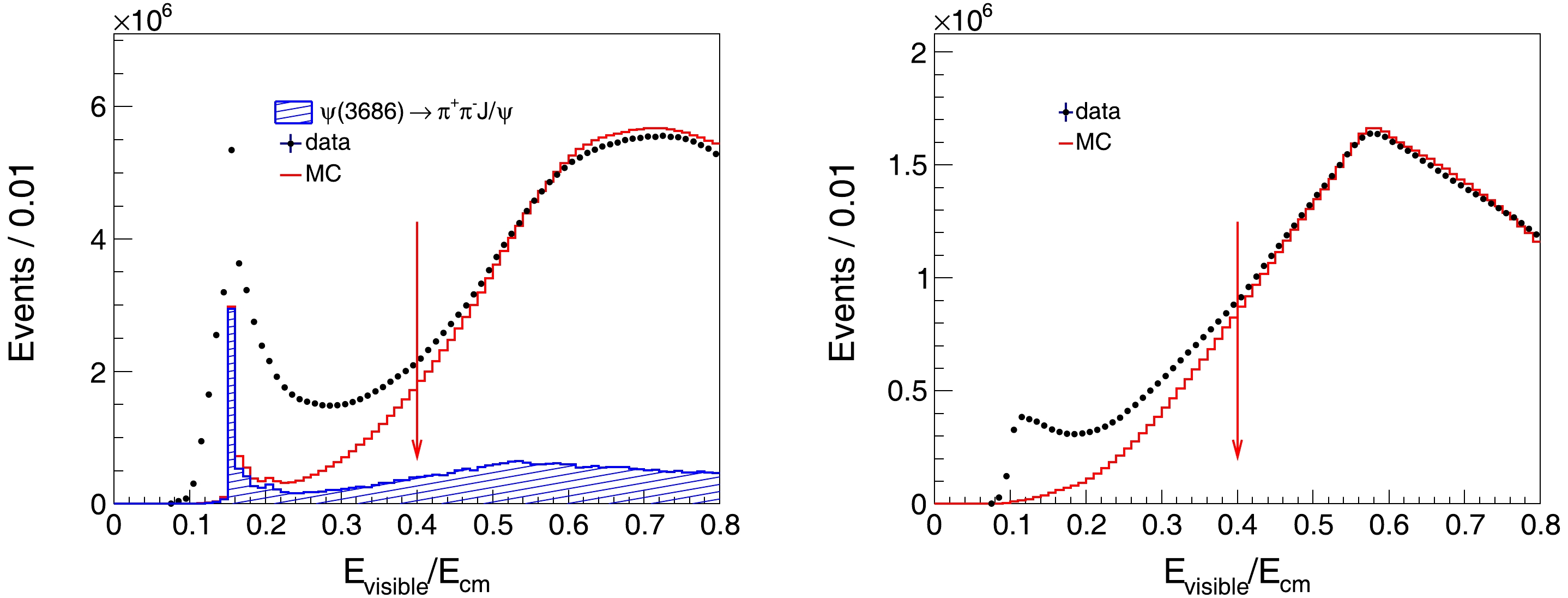
Figure 2. (color online) Distributions of Evisible/Ecm for the type-II (left) and type-I (right) events of the ψ(3686) data and inclusive MC samples. The MC distributions have been scaled to data by using events with Evisible/Ecm > 0.4. The events lying above the red arrows are kept for further analysis.
For the type-I events, at least two photons are required in the event. Compared to those events with high charged track multiplicity, the type-I sample has more background according to the vertex distribution of the charged tracks. Thus, a neutral hadron π0 candidate is required to improve the suppression of background events [4], where the π0 candidate is reconstructed from a
$ \gamma\gamma $ pair. Within each event, only the$ \gamma\gamma $ candidate with invariant mass closest to the π0 nominal mass and satisfying$ |M_{\gamma\gamma}-M_{\pi^0}|< $ 0.015 GeV/c2 is kept for further analysis. Figure 3 shows the$ M_{\gamma\gamma} $ distribution of the selected π0 candidates for type-I events. With the above selection criteria, the corresponding Evisible/Ecm distributions of the candidate events for the ψ(3686) data and inclusive MC samples are shown in Fig. 2(right). An additional requirement of Evisible/Ecm > 0.4 is also used to suppress the LEB events.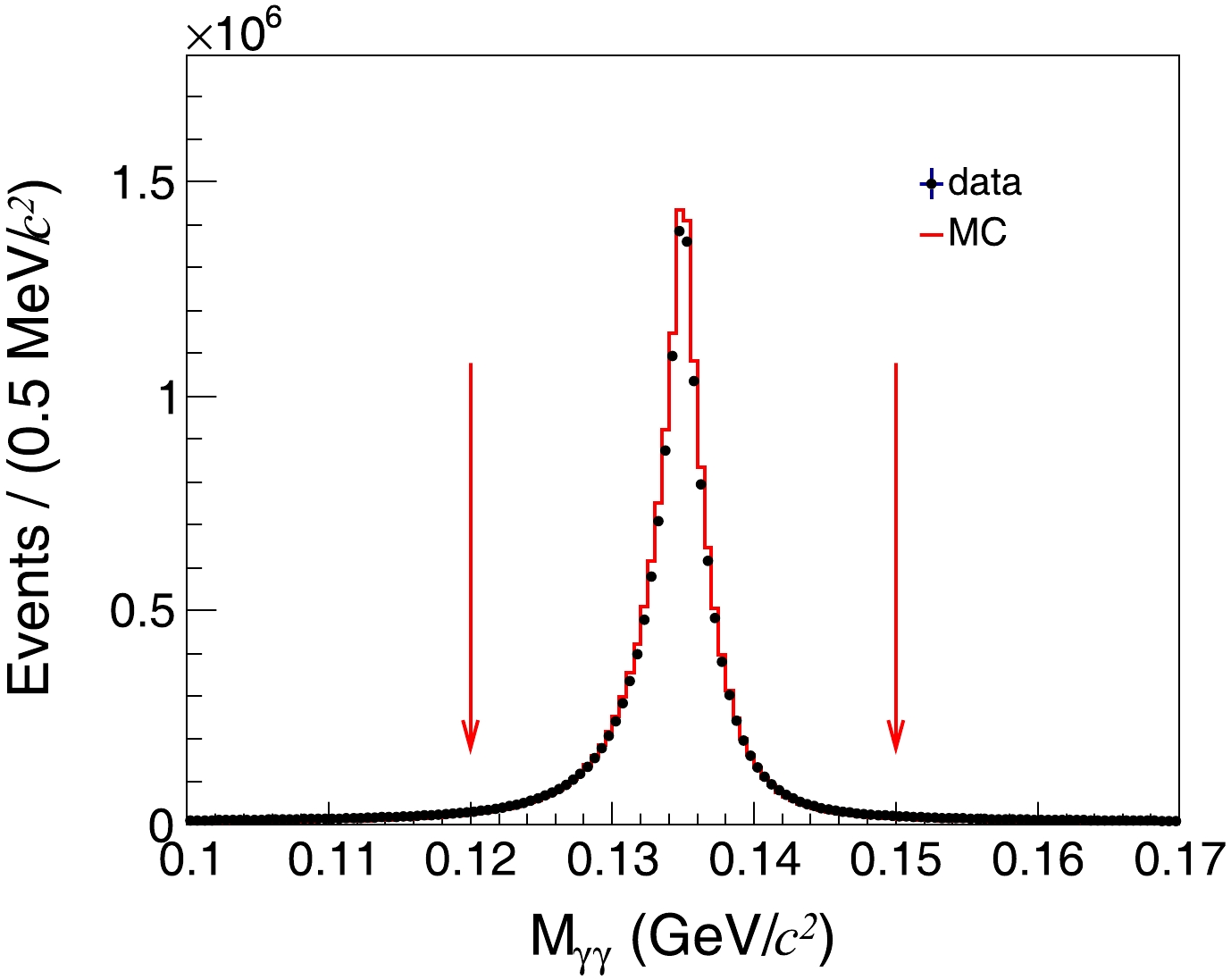
Figure 3. (color online) Distribution of
$M_{\gamma\gamma}$ for the π0 candidates from the type-I events. The region within the pair of red arrows is the$\pi^0$ signal window.The signal yield of
$ e^+e^-\to {\it hadrons} $ is obtained by examining the event vertex distribution VZ. For type-II and type-III events, the VZ is the event vertex fit position, while for type-I events, the VZ is the defined one for single track, i.e., the distance to IP in the z direction. Figure 4 shows the distributions of VZ for ψ(3686) and off-resonance data samples. The region$ |V_Z|<4 $ cm is regarded as the signal region, and the region$ 6 <|{V}_Z|<10 $ cm is taken as the sideband region. Events in the sideband region are mainly from non-collision background events. The number of observed hadronic events (Nobs) is determined by
Figure 4. (color online) The distributions of VZ for the accepted hadronic events of the (left) ψ(3686) data and (right) off-resonance data. The region within the pair of red arrows is the signal region, while the regions within the two pairs of blue arrows are the sideband regions.
$ N^{\rm{obs}} = N_{\rm{signal}} - N_{\rm{sideband}}, $

(1) where
$ N_{\rm{signal}} $ and$ N_{\rm{sideband}} $ are the numbers of events in the signal and sideband regions, respectively. -
Following our previous measurement [4], the number of remaining
$ q\bar q $ background events is estimated using the off-resonance data sample benefiting from the small difference in the c.m. energies, where one expects the qq background is comparable so that can be used to estimate the background in the energy of ψ(3686). We apply the same approach to determine the yields of collision events for the off-resonance data samples, then estimate the contribution at the ψ(3686) resonance after scaling by integrated luminosity. Similarly, the contributions from the ISR return to J/ψ are estimated by the same method as above. The connection between two energy points can be expressed by a scaling factor, f, determined from the integrated luminosity multiplied by 1/s to account for the energy dependence of the cross section. This can be done since the dominant backgrounds come from the Bhabha and dimuon processes at the leading-order contribution [11]. The scale factor is$ f = \frac{{\cal{L}}_{\psi(3686)}}{{\cal{L}}_{{\rm{off}}-{\rm{res}}}}\cdot\frac{3.65^2}{3.686^2}, $

(2) where
${\cal{L}}_{\psi(3686)}$ and${\cal{L}}_{{\rm{off}}-{\rm{res}}}$ are the integrated luminosities of the ψ(3686) data and off-resonance data samples, and 3.6862 and 3.652 are the corresponding squares of c.m. energies, respectively.The integrated luminosities at different energy points are determined using Bhabha events [12] with the following selection criteria. The number of charged tracks is required to be equal to two with net charge zero. Each track must have energy deposited in the EMC between 1.0 GeV and 2.5 GeV and a momentum less than 0.5×Ecm + 0.3 GeV. Furthermore, the sum of the momenta of the positron and electron must be greater than 0.9×Ecm. The cosine of the polar angle (θ) for each track is required to be within
$\left| \cos\theta \right| < 0.8 $ and their ϕ angles must satisfy$ 5^{\circ} <\left| \left| \phi_{1} - \phi_{2} \right| - 180^{\circ} \right| < 40^{\circ} $ . The luminosities of the ψ(3686) and off-resonance data samples taken in 2021 are 3208.5 pb-1 and 401.0 pb-1, with uncertainties of about 1%, respectively.To test if the interference between Bhabha events and
$ \psi(3686)\to e^+e^- $ events affects the luminosity measurement, we examine the integrated luminosities of the ψ(3686) data samples using$ e^+e^-\to\gamma\gamma $ events with the following selection criteria. The number of showers is required to be greater than or equal to two with no candidate charged tracks. Each shower must have deposited energy in the EMC between 1.0 GeV and 2.5 GeV. The cosine of the polar angle (θ) for each shower is required to be within$\left| \cos\theta \right| < 0.8 $ . The two most energetic showers are required to be back to back ($ ||\theta_1 - 90^{\circ}| - |\theta_2 - 90^{\circ}|| < 10^{\circ}$ ) and with ϕ angles$ \left| \left| \phi_{1} - \phi_{2} \right| - 180^{\circ} \right| < 2^{\circ} $ . The difference of the measured luminosities is less than 0.1%.The integrated luminosities of the two off-resonance data samples collected at Ecm=3.65 GeV in 2009 and 2021 are 44.5 and 401.0 pb-1, respectively. The former one is used to estimate the continuum contribution of the 2009 ψ(3686) data sample, and the latter one is used to estimate the continuum contribution of the 2012 and 2021 ψ(3686) data samples. The integrated luminosities of the 2009, 2012, and 2021 ψ(3686) data samples are 161.6,506.9, and 3208.5 pb-1, respectively, with scaling factors f of 3.56, 1.24, and 7.85, respectively. The systematic uncertainties of the luminosities for the two c.m. energies almost cancel when calculating the scaling factors due to the small energy difference.
The cross sections for
$ e^{+}e^{-}\rightarrow {}\tau^{+}\tau^{-} $ are calculated to be 1.84 and 2.14 nb at$ E_{\rm cm}=3.65\;{\rm{GeV}} $ and 3.686 GeV, respectively. Since the above energy points are close to the$ \tau^{+}\tau^{-} $ mass threshold, the production cross section does not follow a 1/s distribution. Thus, only part of the$ e^{+}e^{-}\rightarrow {}\tau^{+}\tau^{-} $ background events is included in the off-resonance data samples. To subtract the full background from$ e^{+}e^{-}\rightarrow {}\tau^{+}\tau^{-} $ , we estimate the remaining contribution,$ N^{\rm{uncanceled}}_{\tau^+\tau^-} $ , using the detection efficiency from the MC simulation, the cross section difference at the two c.m. energy points, and the luminosity at the ψ(3686) peak. The estimated residual$ e^+e^-\to \tau^+\tau^- $ background yields are shown in Table 1.Multiplicity $ N_{\rm{good}}\geq 1 $ 

$ N_{\rm{good}}\geq 2 $ 

$ N_{\rm{good}}\geq 3 $ 

Year 2009 2012 2021 2009 2012 2021 2009 2012 2021 $ N^{\rm{obs}}_{\psi(3686)} (10^6) $ 

107.98 345.14 2246.93 104.77 333.79 2172.16 83.36 264.57 1722.56 f 3.56 1.24 7.85 3.56 1.24 7.85 3.56 1.24 7.85 $ N^{\rm{obs}}_{{\rm{off}}-{\rm{res}}} (10^6) $ 

2.05 18.18 18.18 1.99 17.65 17.65 0.75 6.51 6.51 $ N^{\rm{uncanceled}}_{\tau^{+}\tau^{-}} (10^6) $ 

0.04 0.13 0.80 0.04 0.12 0.76 0.01 0.03 0.22 $ \epsilon $ (%)

93.21 92.83 92.86 90.42 89.65 89.86 74.69 73.39 73.85 $ N_{\psi(3686)} (10^6) $ 

107.96 347.36 2265.08 107.99 347.75 2262.32 108.03 349.46 2262.94 Table 1. Number of hadronic events
$N^{\rm{obs}}_{\psi(3686)}$ in the ψ(3686) data, separately for different requirements on the number of good tracks$ N_{\rm{good}} $ , where$N^{\rm{obs}}_{\psi(3686)}$ is the number of hadronic events observed in the ψ(3686) data, f is the scaling factor,$N^{\rm{obs}}_{{\rm{off}}-{\rm{res}}}$ is the number of hadronic events observed in the off-resonance data,$N^{\rm{uncanceled}}_{\tau^{+}\tau^{-}}$ is the number of remaining$e^{+}e^{-}\rightarrow {}\tau^{+}\tau^{-}$ events after subtracting the normalized off-resonance data,$\epsilon$ is the detection efficiency, and$N_{\psi(3686)}$ is the determined number of ψ(3686) events. The statistical uncertainties are expected to be negligible.The cross section from the ISR return to
$ J/\psi $ is also found to slightly violate the 1/s distribution. However, the corrected cross section difference for this process at the ψ(3686) peak is about 0.1 nb, which is negligible if compared to the total observed cross section of$ \psi(3686)\rightarrow $ hadrons, ~ 700 nb.A small fraction of
$ \psi(3686)\to \ell^+\ell^- $ events survives the event selection. Since their effect has been considered in the detection efficiency, no further subtraction is made.Figure 5 shows the comparisons of the distributions of
$ \cos\theta $ , Evisible/Ecm,$ N_{\rm{good}} $ , and photon multiplicity ($ N_{\gamma} $ ) after background subtraction between data and MC simulation, and a reasonable data-MC agreement is observed. Table 1 summarizes the numbers of the observed hadronic events for different$ N_{\rm{good}} $ requirements of ψ(3686) data ($ N^{\rm{obs}}_{\psi(3686)} $ ) and off-resonance data ($ N^{\rm{obs}}_{{\rm{off}}-{\rm{res}}} $ ). The detection efficiencies of$ \psi(3686)\rightarrow $ hadrons are determined with 2.3 billion ψ(3686) inclusive MC events, where the branching fraction of$ \psi(3686)\rightarrow $ hadrons is included in the efficiency. -
With the numbers listed in Table 1, we determine the number of ψ(3686) events using
$ N_{\psi(3686)} = \frac{N^{\rm{obs}}_{\psi(3686)} - f\cdot N^{\rm{obs}}_{{\rm{off}}-{\rm{res}}} - N^{\rm{uncanceled}}_{\tau^+\tau^-}}{\epsilon}. $

(3) The obtained numerical results for
$ N_{\psi(3686)} $ with different$ N_{\rm{good}} $ requirements are slightly different with each other, mainly due to the imperfect simulation of the charged track multiplicity. To obtain a more accurate$ N_{\psi(3686)} $ , an unfolding method is employed based on an efficiency matrix determined from the ψ(3686) inclusive MC sample. In practice, there are even numbers of charged tracks generated in an event due to charge conservation, while any number of charged tracks can be observed due to the reconstruction efficiency and backgrounds. Therefore, the true multiplicities of charged tracks of the data sample is estimated from the observed multiplicities of charged tracks and the efficiency matrix by minimizing the$ \chi^2 $ , defined as$ \chi^{2} = \sum\nolimits_{i = 0}^{10}\frac{(N^{\rm{obs}}_{i} - \sum_{j = 0}^{10}\epsilon_{ij}\cdot N_{j})^{2}}{N^{\rm{obs}}_{i}} , $

(4) where the values
$ N^{\rm{obs}}_i\; (i=0,\; 1,\; 2,\cdots) $ are the observed multiplicities of charged tracks in the data sample corresponding to the distribution in Fig. 5 (bottom-left, the points with error bars), the matrix elements$ \epsilon_{ij} $ represent the probability to observe i charged tracks for an event with j actual charged tracks, and the values$ N_j\; (j=0,\; 2,\; 4,\cdots) $ are the true multiplicities of charged tracks in the data sample. They are free parameters in the fit. For simplicity, the events with ten or more charged tracks are combined in the number$ N_{10} $ . The$ N_{\psi(3686)} $ is calculated by summing over all the obtained$ N_{j} $ . The results are 107.7×106, 345.4×106 and 2259.3×106 for the 2009, 2012 and 2021 data samples, respectively. -
The systematic uncertainties in the
$ N_{\psi(3686)} $ measurement from different sources are described below and listed in Table 2.Source 2009 2012 2021 Polar angle of charged track 0.25 0.20 0.22 Tracking efficiency negligible negligible negligible Momentum and opening angle 0.20 0.26 0.26 LEB contamination 0.02 0.04 0.12 Extraction method of $ N^{\rm{obs}} $ 

0.16 0.16 0.03 Vertex requirement 0.13 0.08 0.07 Scaling factor (f) negligible negligible negligible π0 mass requirement negligible 0.01 0.05 Missing $ N_{\rm{good}} = 0 $ hadronic events

0.38 0.31 0.11 Charged track multiplicity 0.24 0.56 0.26 MC modeling negligible negligible negligible Trigger efficiency negligible negligible negligible $ {\cal{B}}(\psi(3686)\rightarrow {}{\it hadrons}) $ 

0.13 0.13 0.13 Total 0.60 0.75 0.49 Table 2. Relative systematic uncertainties (%) in the determination of the number of ψ(3686) events.
-
The polar angles of charged tracks are required to satisfy
$ |\cos\theta|<0.93 $ . To estimate the relevant systematic uncertainty, we redo the measurement with an alternative requirement of$ |\cos\theta|< $ 0.8. The difference in the measured number of ψ(3686) events is taken as the systematic uncertainty. -
The systematic uncertainties due to the tracking efficiency for both the 2009 and 2012 data samples have been found to be negligible based on various studies [4]. Therefore, the associated systematic uncertainty for the 2021 data sample is also ignored.
-
To estimate the systematic uncertainty due to the requirement on charged track momentum for the type-II events, we vary the nominal requirement from p<1.7 GeV/c to p<1.55 GeV/c, and the opening angle between two charged tracks from
$ \theta<176^{\circ} $ to$ \theta<160^{\circ} $ . The change in$ N_{\psi(3686)} $ is taken as the corresponding systematic uncertainty. -
In the nominal measurement, the
$ E_{\rm visible}/E_{\rm cm}<0.4 $ requirement is used to suppress the LEB background events for the type-I and type-II events. The systematic uncertainty due to this requirement is assigned with alternative requirements of$ E_{\rm visiable}/E_{\rm cm}<0.35 $ and$ E_{\rm visiable}/E_{\rm cm}<0.45 $ . The larger change in$ N_{\psi(3686)} $ is assigned as the systematic uncertainty. -
The nominal measurement is performed by counting the events in the VZ distributions in Fig. 4. To examine the systematic uncertainty associated with the counting method, we use an alternative method by fitting the VZ distributions with three linearly added Gaussian functions to model the signal shape and a second order polynomial function to describe the non-collision background. The difference in the determined
$ N_{\psi(3686)} $ values between these two methods is taken as the systematic uncertainty. -
To estimate the systematic uncertainties due to the vertex requirement, we examine the number of ψ(3686) events after varying the nominal vertex requirements of
$ V_r $ <1 cm to$ V_r $ <2 cm, and from$ |V_z|<10 $ cm to$ |V_z|<15 $ cm. The change in the measured number of ψ(3686) events is taken as the systematic uncertainty. -
The systematic uncertainty due to the scaling factor f is estimated with the alternatively measured luminosities with
$e^{+}e^{-}\rightarrow {}\gamma\gamma$ events. The change of the re-measured$ N_{\psi(3686)} $ is found to be negligible and this systematic uncertainty is therefore neglected. -
A requirement of
$ |M_{\gamma\gamma}-M_{\pi^0}|$ <0.015 GeV/c2 has been imposed on the type-I events to suppress background. Its effect on the measured number of ψ(3686) events is studied with an alternative requirement of$ |M_{\gamma\gamma}-M_{\pi^0}|$ <0.025 GeV/c2. The change in$ N_{\psi(3686)} $ is taken as the systematic uncertainty. -
We do not consider the
$ N_{\rm{good}}=0 $ hadronic events in the nominal measurement. The topological analysis for the ψ(3686) inclusive MC samples shows that most of these events come from well-known decay channels, such as$ \psi(3686)\rightarrow {} X+ J/\psi $ (where X denotes η, π0,$ \pi^0\pi^0 $ ,$ \gamma\gamma $ , etc.) and$ \psi(3686)\rightarrow {}e^{+}e^{-} $ ,$ \mu^+\mu^- $ . The fraction of$ N_{\rm{good}} = 0 $ hadronic events is ~2.0%, and the pure neutral channels contribute about 1.0%.We examine the effect of the
$ N_{\rm{good}}=0 $ hadronic events as follows. A sample is selected using the requirements$ N_{\rm{good}}=0 $ and$ N_{\gamma}>3 $ , where the good charged tracks and showers are selected with the same criteria mentioned above. The$ N_{\gamma}>3 $ requirement is used to suppress the$e^{+}e^{-}\rightarrow {}\gamma\gamma$ and beam-associated background events. Figure 6 shows the distributions of the total energy in the EMC,$ E_{\rm{EMC}} $ , for the different data sets and inclusive MC samples. The events concentrated around the c.m. energy are mainly from the pure neutral hadronic candidates. The number of signal events is determined by a fit to the$ E_{\rm{EMC}} $ distribution. In this fit, the signal is described by a Breit-Wigner function convolved with Crystal Ball function, the nonresonant background in the ψ(3686) data sample is described by the shape of off-resonance data sample after luminosity normalization, and the other backgrounds are described by a polynomial function. For the 2021 data sample, the difference in the number of pure neutral hadronic events between the ψ(3686) data and inclusive MC samples is 11%. Since the fraction of the pure neutral hadronic events is about 1% of the total selected hadronic events, the systematic uncertainty due to the missing$ N_{\rm{good}} = 0 $ hadronic events must be less than 11%×1% = 0.11% for the 2021 data sample. With the same method, the systematic uncertainties for the 2009 and 2012 data samples are assigned as 0.38% and 0.31%, respectively.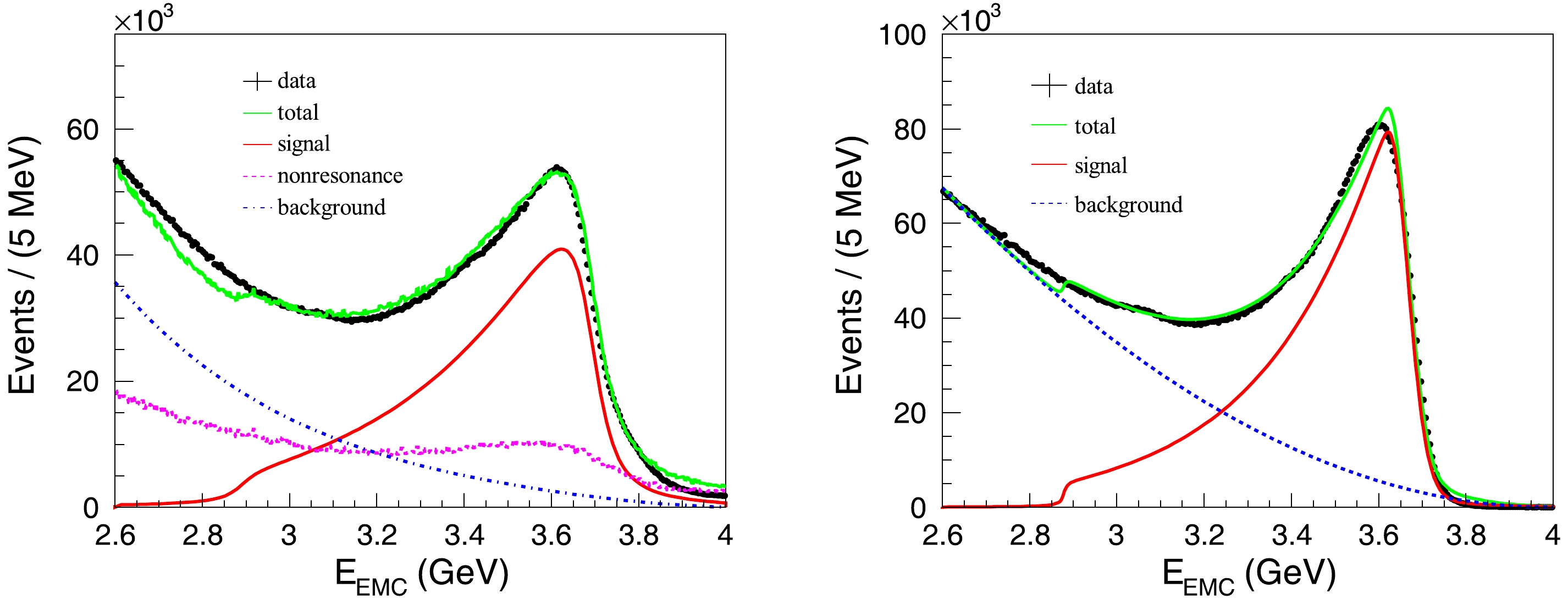
Figure 6. (color online) Distributions of
$ E_{\rm{EMC}} $ for the$ N_{\rm{good}}=0 $ hadronic events from the ψ(3686) data (left) and inclusive MC (right) samples. The black points with error bar are data. The red lines are the signal shapes of neutral ψ(3686) decays, the blue lines are the background shapes from ψ(3686) decays, the pink line is the total background shape from nonresonant processes, and the green lines are the final fit curves. -
To estimate the systematic uncertainty arising from the charged track multiplicity, we compare the directly calculated result as shown in Table 1 and that obtained with the unfolding method after including the
$ N_{\rm good}\leq 1 $ events. The differences in the numbers of ψ(3686) events for the 2009, 2012 and 2021 data samples, which are 0.24%, 0.56%, and 0.26%, respectively, are taken as individual systematic uncertainties. -
The systematic uncertainties due to MC modeling include the input branching fractions and the angular distributions of the known and unknown decay modes in the ψ(3686) inclusive MC sample. These uncertainties have been covered by those of the charged track multiplicity and the missing
$ N_{\rm{good}} = 0 $ events. Hence no systematic uncertainty is assigned for the MC modeling. -
The trigger efficiencies for BESIII data were studied in 2010 [13] and 2021 [14]. The trigger efficiency for the
$ N_{\rm{good}}\geq2 $ (type-II and type-III) events is found to be close to 100.0%, while it is 98.7% for the type-I events [13]. Since the fraction of the type-I events is only about 3% of the total selected hadronic events, the associated systematic uncertainty is negligible. The neutral channel trigger has been added since 2012, and the trigger efficiency for the type-I events is expected to be higher than before. Therefore, the systematic uncertainty associated with the trigger efficiency is negligible. -
The uncertainty of the branching fraction of
$\psi(3686)\rightarrow $ hadrons, 0.13% [1−3], is taken as a systematic uncertainty. -
The total systematic uncertainty for each ψ(3686) data sample is obtained as the quadratic sum of all the systematic uncertainties.
-
By analyzing inclusive hadronic events, the number of ψ(3686) events taken by the BESIII detector in 2021 is measured to be (2259.3±11.1)×106, where the uncertainty is systematic and the statistical uncertainty is negligible. The numbers of ψ(3686) events taken in 2009 and 2012 are also updated to be (107.7±0.6)×106 and (345.4±2.6)×106, respectively. Both are consistent with the previous measurements within one standard deviation, and a slight difference in the 2012 ψ(3686) events relative to the previous one is caused by changing the off-resonance data from the previous τ-scan data to the off-resonance data at
$ \sqrt{s}= $ 3.65 GeV in 2021. The total number of ψ(3686) events for the three data samples is obtained to be (2712.4±14.3)×106 by adding the above three yields linearly. This work provides an important parameter used in precision measurements of decays of the ψ(3686) and its daughter charmonium particles. -
The BESIII collaboration thanks the staff of BEPCII and the IHEP computing center for their strong support.
Determination of the number of ψ(3686) events taken at BESIII
- Received Date: 2024-03-12
- Available Online: 2024-10-01
Abstract: The number of ψ(3686) events collected by the BESIII detector during the 2021 run period is determined to be (2259.3±11.1)×106 by counting inclusive ψ(3686) hadronic events. The uncertainty is systematic and the statistical uncertainty is negligible. Meanwhile, the numbers of ψ(3686) events collected during the 2009 and 2012 run periods are updated to be (107.7±0.6)×106 and (345.4±2.6)×106, respectively. Both numbers are consistent with the previous measurements within one standard deviation. The total number of ψ(3686) events in the three data samples is (2712.4±14.3)×106.






 Abstract
Abstract HTML
HTML Reference
Reference Related
Related PDF
PDF


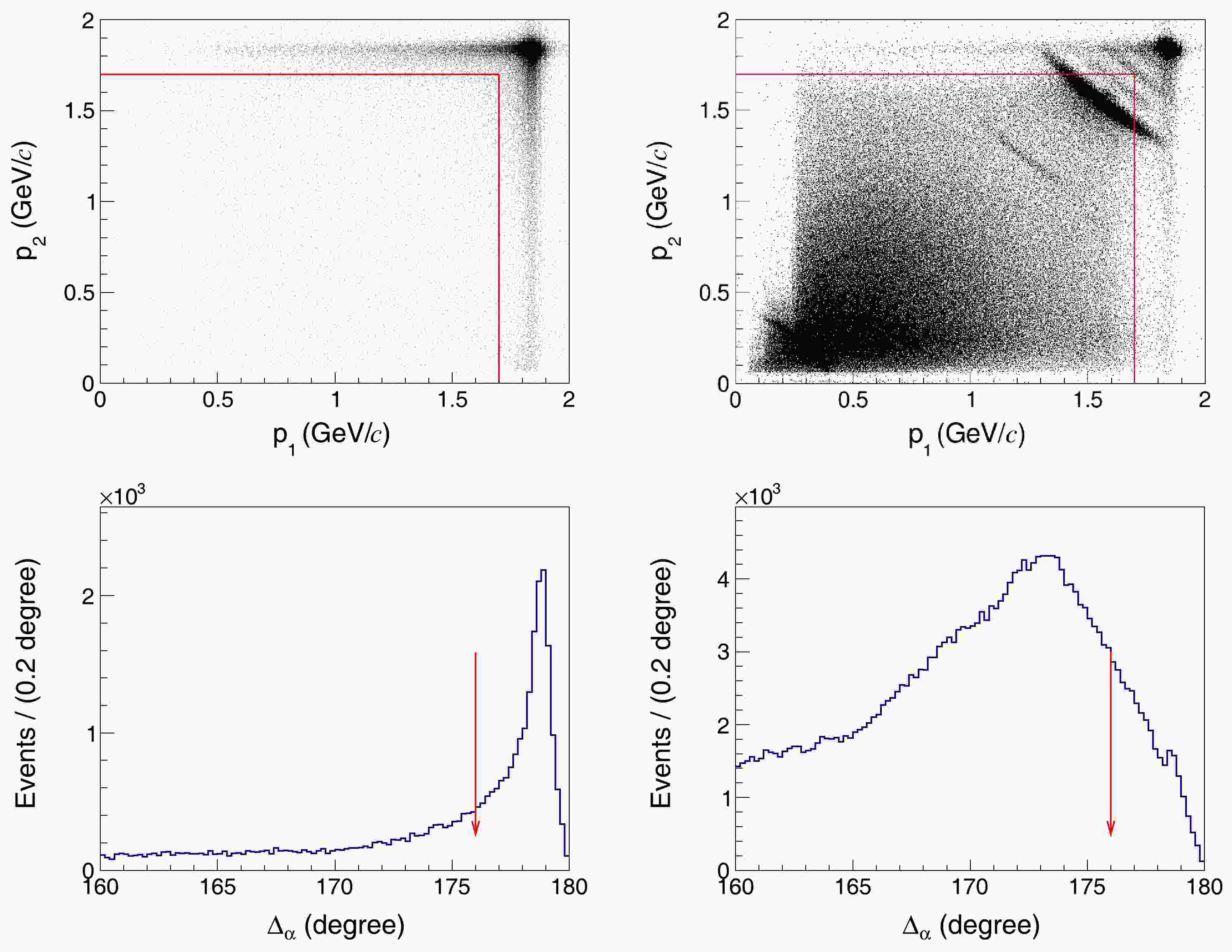










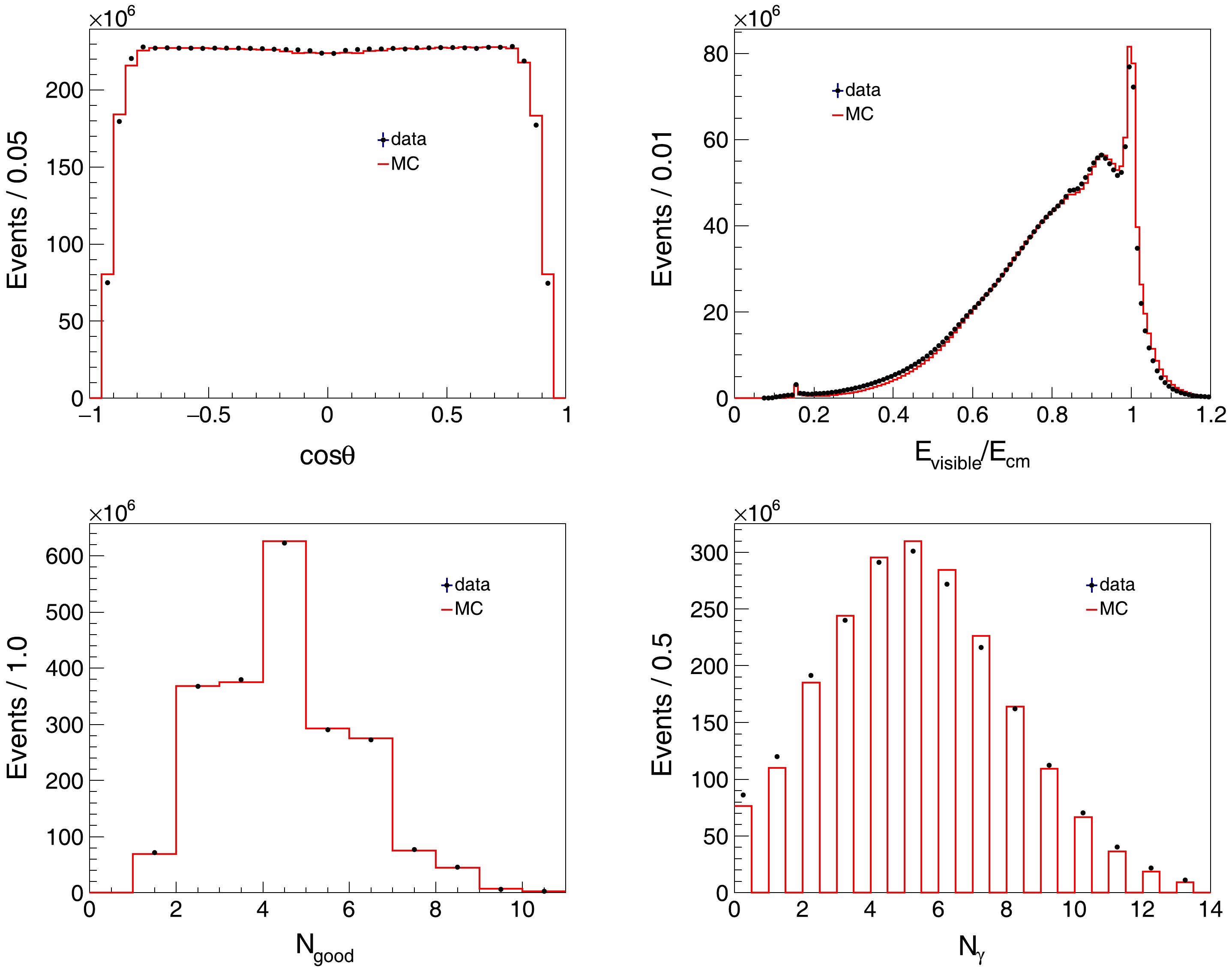



 DownLoad:
DownLoad:
